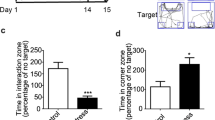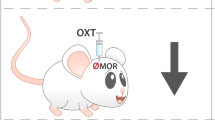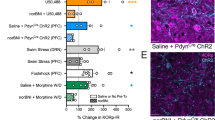Abstract
Stress and anxiety are mainly regulated by amygdala and hypothalamic circuitries involving several neurotransmitter systems and providing physiological responses to peripheral organs via the hypothalamic–pituitary–adrenal axis and other pathways. The role of endogenous opioid peptides in this process is largely unknown. Here we show for the first time that anxiolytic parameters of explorative behavior in mice lacking prodynorphin were increased 2–4-fold in the open field, the elevated plus maze and the light–dark test. Consistent with this, treatment of wild-type mice with selective κ-opioid receptor antagonists GNTI or norbinaltorphimine showed the same effects. Furthermore, treatment of prodynorphin knockout animals with U-50488H, a selective κ-opioid receptor agonist, fully reversed their anxiolytic phenotype. These behavioral data are supported by an approximal 30% reduction in corticotropin-releasing hormone (CRH) mRNA expression in the hypothalamic paraventricular nucleus and central amygdala and an accompanying 30–40% decrease in corticosterone serum levels in prodynorphin knockout mice. Although stress-induced increases in corticosterone levels were attenuated in prodynorphin knockout mice, they were associated with minor increases in depression-like behavior in the tail suspension and forced swim tests. Taken together, our data suggest a pronounced impact of endogenous prodynorphin-derived peptides on anxiety, but not stress coping ability and that these effects are mediated via κ-opioid receptors. The delay in the behavioral response to κ-opioid receptor agonists and antagonist treatment suggests an indirect control level for the action of dynorphin, probably by modulating the expression of CRH or neuropeptide Y, and subsequently influencing behavior.
Similar content being viewed by others
Log in or create a free account to read this content
Gain free access to this article, as well as selected content from this journal and more on nature.com
or
References
Aguiar MS, Brandao ML (1996). Effects of microinjections of the neuropeptide substance P in the dorsal periaqueductal gray on the behaviour of rats in the plus-maze test. Physiol Behav 60: 1183–1186.
Bachli H, Steiner MA, Habersetzer U, Wotjak CT (2008). Increased water temperature renders single-housed C57BL/6J mice susceptible to antidepressant treatment in the forced swim test. Behav Brain Res 187: 67–71.
Bale TL, Contarino A, Smith GW, Chan R, Gold LH, Sawchenko PE et al (2000). Mice deficient for corticotropin-releasing hormone receptor-2 display anxiety-like behaviour and are hypersensitive to stress. Nat Genet 24: 410–414.
Bilkei-Gorzo A, Racz I, Michel K, Mauer D, Zimmer A, Klingmuller D et al (2008). Control of hormonal stress reactivity by the endogenous opioid system. Psychoneuroendocrinology 33: 425–436.
Brunello N, Blier P, Judd LL, Mendlewicz J, Nelson CJ, Souery D et al (2003). Noradrenaline in mood and anxiety disorders: basic and clinical studies. Int Clin Psychopharmacol 18: 191–202.
Coste SC, Kesterson RA, Heldwein KA, Stevens SL, Heard AD, Hollis JH et al (2000). Abnormal adaptations to stress and impaired cardiovascular function in mice lacking corticotropin-releasing hormone receptor-2. Nat Genet 24: 403–409.
Crawley JN (1999). Behavioral phenotyping of transgenic and knockout mice: experimental design and evaluation of general health, sensory functions, motor abilities, and specific behavioral tests. Brain Res 835: 18–26.
Ebner K, Rupniak NM, Saria A, Singewald N (2004). Substance P in the medial amygdala: emotional stress-sensitive release and modulation of anxiety-related behavior in rats. Proc Natl Acad Sci USA 101: 4280–4285.
Ebner K, Singewald N (2006). The role of substance P in stress and anxiety responses. Amino Acids 31: 251–272.
Engelhardt G, Homma D, Schlegel K, Schnitzler C, Utzmann R (1996). General pharmacology of meloxicam—Part I: effects on CNS, gastric emptying, intestinal transport, water, electrolyte and creatinine excretion. Gen Pharmacol 27: 673–677.
Gavioli EC, Canteras NS, De Lima TC (1999). Anxiogenic-like effect induced by substance P injected into the lateral septal nucleus. Neuroreport 10: 3399–3403.
Graeff FG (2002). On serotonin and experimental anxiety. Psychopharmacology (Berl) 163: 467–476.
Hamke M, Herpfer I, Lieb K, Wandelt C, Fiebich BL (2006). Substance P induces expression of the corticotropin-releasing factor receptor 1 by activation of the neurokinin-1 receptor. Brain Res 1102: 135–144.
Heilig M, Koob GF, Ekman R, Britton KT (1994). Corticotropin-releasing factor and neuropeptide Y: role in emotional integration. Trends Neurosci 17: 80–85.
Holm S (1979). A simple sequentially rejective multiple test procedure. Scand J Stat 6: 65–70.
Jewett DC, Grace MK, Jones RM, Billington CJ, Portoghese PS, Levine AS (2001). The kappa-opioid antagonist GNTI reduces U50,488-, DAMGO-, and deprivation-induced feeding, but not butorphanol- and neuropeptide Y-induced feeding in rats. Brain Res 909: 75–80.
Jones RM, Portoghese PS (2000). 5′-Guanidinonaltrindole, a highly selective and potent kappa-opioid receptor antagonist. Eur J Pharmacol 396: 49–52.
Karl T, Pabst R, von Horsten S (2003). Behavioral phenotyping of mice in pharmacological and toxicological research. Exp Toxicol Pathol 55: 69–83.
Karlsson RM, Choe JS, Cameron HA, Thorsell A, Crawley JN, Holmes A et al (2008). The neuropeptide Y Y1 receptor subtype is necessary for the anxiolytic-like effects of neuropeptide Y, but not the antidepressant-like effects of fluoxetine, in mice. Psychopharmacology (Berl) 195: 547–557.
Kask A, Harro J, von Horsten S, Redrobe JP, Dumont Y, Quirion R (2002). The neurocircuitry and receptor subtypes mediating anxiolytic-like effects of neuropeptide Y. Neurosci Biobehav Rev 26: 259–283.
Kask A, Schioth HB, Mutulis F, Wikberg JE, Rago L (2000). Anorexigenic cocaine- and amphetamine-regulated transcript peptide intensifies fear reactions in rats. Brain Res 857: 283–285.
Kishimoto T, Radulovic J, Radulovic M, Lin CR, Schrick C, Hooshmand F et al (2000). Deletion of crhr2 reveals an anxiolytic role for corticotropin-releasing hormone receptor-2. Nat Genet 24: 415–419.
Knoll AT, Meloni EG, Thomas JB, Carroll FI, Carlezon WA (2007). Anxiolytic-like effects of {kappa}-opioid receptor antagonists in models of unlearned and learned fear in rats. J Pharmacol Exp Ther 323: 838–845.
Kudryavtseva NN, Gerrits MA, Avgustinovich DF, Tenditnik MV, Van Ree JM (2004). Modulation of anxiety-related behaviors by mu- and kappa-opioid receptor agonists depends on the social status of mice. Peptides 25: 1355–1363.
Kuzmin A, Madjid N, Terenius L, Ogren SO, Bakalkin G (2006). Big dynorphin, a prodynorphin-derived peptide produces NMDA receptor-mediated effects on memory, anxiolytic-like and locomotor behavior in mice. Neuropsychopharmacology 31: 1928–1937.
Land BB, Bruchas MR, Lemos JC, Xu M, Melief EJ, Chavkin C (2008). The dysphoric component of stress is encoded by activation of the dynorphin kappa-opioid system. J Neurosci 28: 407–414.
Lin S, Boey D, Lee N, Schwarzer C, Sainsbury A, Herzog H (2006). Distribution of prodynorphin mRNA and its interaction with the NPY system in the mouse brain. Neuropeptides 40: 115–123.
Loacker S, Sayyah M, Wittmann W, Herzog H, Schwarzer C (2007). Endogenous dynorphin in epileptogenesis and epilepsy: anticonvulsant net effect via kappa opioid receptors. Brain 130: 1017–1028.
Marchant NJ, Densmore VS, Osborne PB (2007). Coexpression of prodynorphin and corticotrophin-releasing hormone in the rat central amygdala: evidence of two distinct endogenous opioid systems in the lateral division. J Comp Neurol 504: 702–715.
McLaughlin JP, Marton-Popovici M, Chavkin C (2003). Kappa opioid receptor antagonism and prodynorphin gene disruption block stress-induced behavioral responses. J Neurosci 23: 5674–5683.
Narita M, Kaneko C, Miyoshi K, Nagumo Y, Kuzumaki N, Nakajima M et al (2006). Chronic pain induces anxiety with concomitant changes in opioidergic function in the amygdala. Neuropsychopharmacology 31: 739–750.
Olivier B, Zethof T, Pattij T, van Boogaert M, van Oorschot R, Leahy C et al (2003). Stress-induced hyperthermia and anxiety: pharmacological validation. Eur J Pharmacol 463: 117–132.
Sainsbury A, Schwarzer C, Couzens M, Herzog H (2002). Y2 receptor deletion attenuates the type 2 diabetic syndrome of ob/ob mice. Diabetes 51: 3420–3427.
Sajdyk TJ, Shekhar A, Gehlert DR (2004). Interactions between NPY and CRF in the amygdala to regulate emotionality. Neuropeptides 38: 225–234.
Schoffelmeer AN, Hogenboom F, Mulder AH (1997). Kappa1- and kappa2-opioid receptors mediating presynaptic inhibition of dopamine and acetylcholine release in rat neostriatum. Br J Pharmacol 122: 520–524.
Schwarzer C, Kofler N, Sperk G (1998). Up-regulation of neuropeptide Y-Y2 receptors in an animal model of temporal lobe epilepsy. Mol Pharmacol 53: 6–13.
Sharifi N, Diehl N, Yaswen L, Brennan MB, Hochgeschwender U (2001). Generation of dynorphin knockout mice. Brain Res Mol Brain Res 86: 70–75.
Shepard JD, Barron KW, Myers DA (2000). Corticosterone delivery to the amygdala increases corticotropin-releasing factor mRNA in the central amygdaloid nucleus and anxiety-like behavior. Brain Res 861: 288–295.
Smith GW, Aubry JM, Dellu F, Contarino A, Bilezikjian LM, Gold LH et al (1998). Corticotropin releasing factor receptor 1-deficient mice display decreased anxiety, impaired stress response, and aberrant neuroendocrine development. Neuron 20: 1093–1102.
Solbrig MV, Adrian R, Baratta J, Lauterborn JC, Koob GF (2006). Kappa opioid control of seizures produced by a virus in an animal model. Brain 129: 642–654.
Stanek LM (2006). Cocaine- and amphetamine related transcript (CART) and anxiety. Peptides 27: 2005–2011.
Stenzel-Poore MP, Duncan JE, Rittenberg MB, Bakke AC, Heinrichs SC (1996). CRH overproduction in transgenic mice: behavioral and immune system modulation. Ann NY Acad Sci 780: 36–48.
Timpl P, Spanagel R, Sillaber I, Kresse A, Reul JM, Stalla GK et al (1998). Impaired stress response and reduced anxiety in mice lacking a functional corticotropin-releasing hormone receptor 1. Nat Genet 19: 162–166.
Tsuda M, Suzuki T, Misawa M, Nagase H (1996). Involvement of the opioid system in the anxiolytic effect of diazepam in mice. Eur J Pharmacol 307: 7–14.
Vlachakis ND, De Guia D, Mendlowitz M, Antram S, Wolf RL (1974). Hypertension and anxiety. A trial with epinephrine and norepinephrine infusion. Mt Sinai J Med 41: 615–625.
Wahlestedt C, Pich EM, Koob GF, Yee F, Heilig M (1993). Modulation of anxiety and neuropeptide Y-Y1 receptors by antisense oligodeoxynucleotides. Science 259: 528–531.
Wang Z, Gardell LR, Ossipov MH, Vanderah TW, Brennan MB, Hochgeschwender U et al (2001). Pronociceptive actions of dynorphin maintain chronic neuropathic pain. J Neurosci 21: 1779–1786.
Westenberg HG, den Boer JA, Kahn RS (1987). Psychopharmacology of anxiety disorders: on the role of serotonin in the treatment of anxiety states and phobic disorders. Psychopharmacol Bull 23: 145–149.
Wise CD, Berger BD, Stein L (1970). Serotonin: a possible mediator of behavioral suppression induced by anxiety. Dis Nerv Syst 31 (Suppl): 34–37.
Wollemann M, Benyhe S (2004). Non-opioid actions of opioid peptides. Life Sci 75: 257–270.
Acknowledgements
We thank Cornelia Aigner and Inge Kapeller for excellent technical assistance. We also thank Dr Gerald Obermair for statistical advice.
Author information
Authors and Affiliations
Corresponding author
Additional information
DISCLOSURE/CONFLICT OF INTEREST
This work was supported by the Austrian Science Fund grants P18471-B5 and P20107-B5 to Christoph Schwarzer. Other authors have nothing to disclose.
Supplementary Information accompanies the paper on the Neuropsychopharmacology website (http://www.nature.com/npp)
Supplementary information
Rights and permissions
About this article
Cite this article
Wittmann, W., Schunk, E., Rosskothen, I. et al. Prodynorphin-Derived Peptides Are Critical Modulators of Anxiety and Regulate Neurochemistry and Corticosterone. Neuropsychopharmacol 34, 775–785 (2009). https://doi.org/10.1038/npp.2008.142
Published:
Issue date:
DOI: https://doi.org/10.1038/npp.2008.142
Keywords
This article is cited by
-
The importance of activity-specific differentiation between orientation-related temperament traits
Current Psychology (2024)
-
Biallelic mutations in the death domain of PIDD1 impair caspase-2 activation and are associated with intellectual disability
Translational Psychiatry (2021)
-
Association between prodynorphin gene polymorphisms and opioid dependence susceptibility: a meta-analysis
BMC Psychiatry (2019)
-
The hypothalamus and neuropsychiatric disorders: psychiatry meets microscopy
Cell and Tissue Research (2019)
-
The anxiolytic- and antidepressant-like effects of ATPM-ET, a novel κ agonist and μ partial agonist, in mice
Psychopharmacology (2016)



